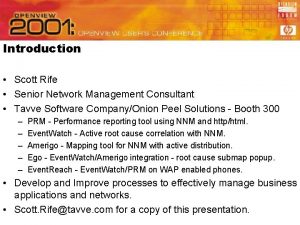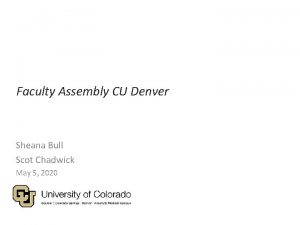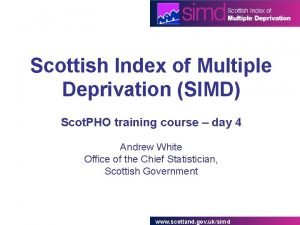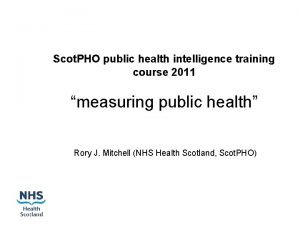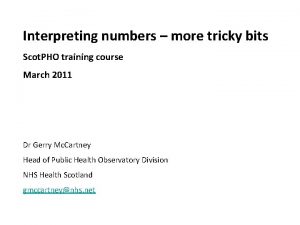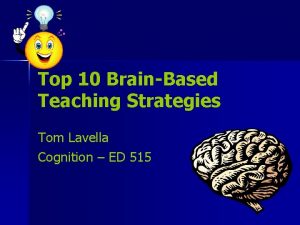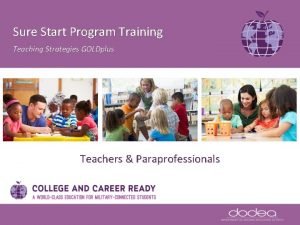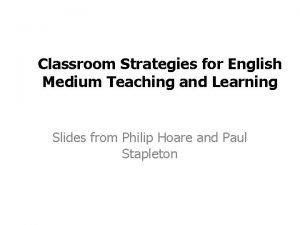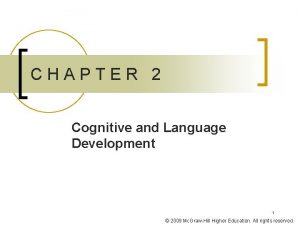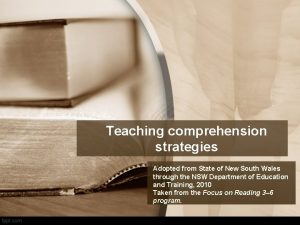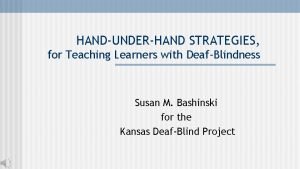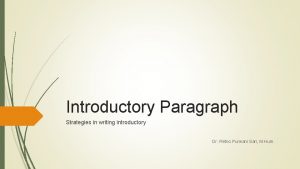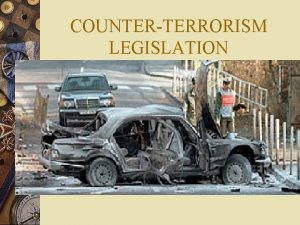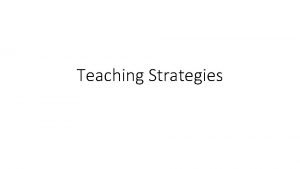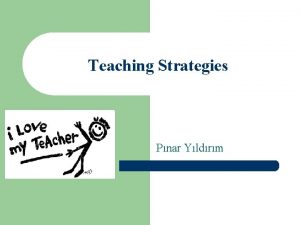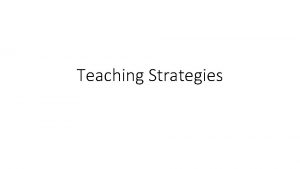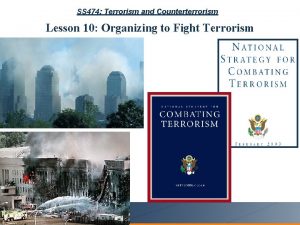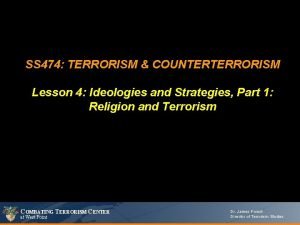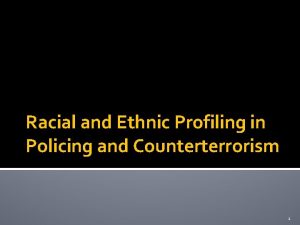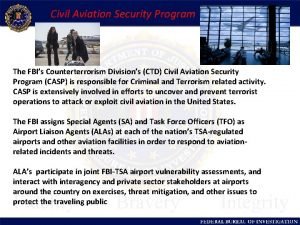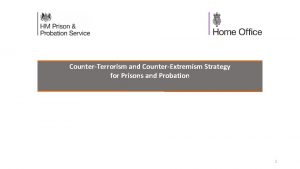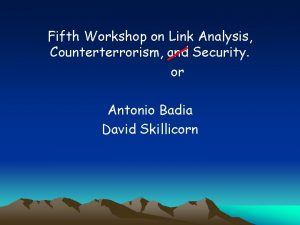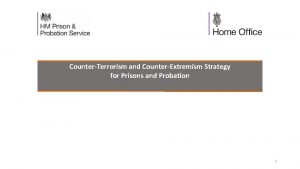Experiences in Teaching Introduction to Counterterrorism Strategies Scot





















- Slides: 21

Experiences in Teaching Introduction to Counterterrorism Strategies Scot Phelps, JD, MPH, Paramedic Associate Professor of Public Administration/Emergency Management Metropolitan College, NYC

Background Synergy for Program • MCNY Graduate Students have 2 days of red team/blue team counterterrorism planning (school & mall) with a former Israeli Secret Service instructor as part of our annual Israeli program.

RMS Reference Manuals • Reference Manuals – FEMA 426 - Reference Manual to Mitigate Potential Terrorist Attacks Against Buildings – FEMA 427 - Primer for Design of Commercial Buildings to Mitigate Terrorist Attacks – FEMA 428 - Primer to Design Safe School Projects in Case of Terrorist Attacks – FEMA 429 - Insurance, Finance, and Regulation Primer for Terrorism Risk Management in Buildings – FEMA 452 - A How-To Guide to Mitigate Potential Terrorist Attacks Against Buildings – FEMA 453 - Safe Rooms and Shelters: Protecting People Against Terrorist Attacks – E 155 - Building Design for Homeland Security: Student Manual • Future Publications – FEMA 430 - Primer for Incorporating Building Security Components in Architectural Design – FEMA 455 - Rapid Visual Screening for Building Security – FEMA 459 - Incremental Rehabilitation to Improve Security in Buildings

FEMA’s Assessment Tool ü ü ü • Every standard tied to GSA, DOD, or VA standards Survey is 52 -pages long and involves 13 building systems Focused on suicide bombers, CBRNE, and gunmen Questions overlap between sections for verification Followed by walk-around DHS threat assessment tool is too simple (12 pages vs. 52 pages) • • Site • Architectural • Structural Systems • Building Envelope • Utility Systems • Mechanical Systems Plumbing & Gas Systems Electrical Systems Fire Alarm Communications & Information Technology Equipment Operations & Maintenance Security Systems Security Master Plan

Background Synergy for Program • I consult to 35 hospitals and was interested in providing a terrorism assessment tool • I have completed over 15 full day assessments at area hospitals.

E 155 Building Design for Homeland Security • Building Design for Homeland Security – – – Plan of Instruction Instructor Guide Student Guide Power. Point (Adobe) http: //www. fema. gov/pl an/prevent/rmsp 1 55

Differences • Building Design for Homeland Security – Taught from engineering /architectural standpoint – Taught over 3 days – No hands on @ home • Introduction to Counterterrorism Planning – Taught from emergency management/security standpoint – Taught over semester – Require hands-on exercise using blind grading

Course Modules • Unit I – Introduction and Course Overview (90 min) • Unit II – Asset Value Assessment (75 min) • Unit III – Threat/Hazard Assessment (75 min) • Unit IV – Vulnerability Assessment (105 min) • Unit V – Risk Assessment/Risk Management (75 min)

Course Modules • Unit VI – Explosive Blast (60 min) • Unit VII – Chemical, Biological, and Radiological (CBR) (60 min) Midterm Review • Midterm

Course Modules • Unit VIII – Site and Layout Design Guidance (150 min) • Unit l. X – Building Design Guidance (150 min) • Unit X – Electronic Security Systems (45 min) • Take Home Exam • Course Wrap-up

Marketing & Structure • Beta trial/free • Taught in partnership with NYUMC Emergency Management, MHSSD • Marketed to current graduate students and through NYC OEM emailing

Student Metrics • 55 students registered, 23 graduates • Students from: – – – local government (23%), hospitals (19. 2%), non-profit (19. 2%), state (11. 5%), and students (15. 4) • 64% were responsible for counterterrorism protection • 53. 8% had not previously taken a counterterrorism class

Participating Agencies • Army National Guard • Hospitals Security (nonprofit) • Hospital Police (public) • Ambulance (private) • Ambulance (nonprofit/911) • Educational Institutions • Extended Care Facilities • Property Management • NYC Office of Emergency Management • NYC Port Services • NYC Human Resources Police • NYPD (retired) • Private Security Consultants • New York State Insurance • Graduate Students • Red Cross

Lessons Learned-Structure • Semester model allowed for more learning and student interaction • 42% of respondents felt the class should be offered weekly, in the evening • 23% of respondents felt the class should be offered as a long weekend • 12% of respondents felt the class should be offered weekly, during business hours

Lessons Learned-Content • Case study in manual needs improvement • Student guide is of marginal use • Students need the Reference Manual, not just the E 155 student guide • Hands-on experience important for knowledge integration

Lessons Learned-Content • Midterm was scenario-based open-book, open-note, open-collaboration- VERY SUCCESSFUL for the adult learner • Because of the security issues surrounding final exam assessment of own facility, submissions were coded.

Lessons Learned-Process • Grading using colors (go-slow-no go) – Green (competent), – Yellow (needs improvement), – Red (not sufficient) was successful and low-pressure

Liked Most (all first choices) • • • Real world examples to discuss • mitigation process • Provided source documents for • future reference • The almost immediate start of exercising mock scenarios • Instructors seemed knowledgeable • Holistic approach to subject • FEMA materials • Heightened awareness of • vulnerabilities • Explanations and lessons applied • Instructor offers invaluable insight • through massive experience. Security issues Real Life Examples Dynamic instructor(s). It gives you the fundamental of combating terrorism at home. Class participation Instructors Instructor's enthusiasm for topic Knowledgeable Instructors All Hazards approach Excellent instructor. The pace was swift Can use within my field

Liked Least (all first choices) • • • Security equipment must be used by trained people Length in weeks could have been reduced Written material needs to be more reader friendly Should have been offered on campus Scheduling Insure sufficient materials on first days A simplified manual Physical security Flexible Schedule • • • Call it what it is. . . this was a Risk Assessment course, that could be applied against many hazards/threats, not just Terrorism. More materials should be provided Field exercises Some information was contrary to training I have received previously More hands on work shops More practical exercises needed Field exercises. More hands-on work in class Include reading material

Value Metrics • 88% rated the instructor as "excellent" or "very good" • 77% rated the class as "valuable" or "very valuable" • 69% rated the reference manual as "valuable" or "very valuable" • 64% rated the textbook (student textbook) as "valuable" or "very valuable" • 64% rated the Power. Point as "valuable" or "very valuable"

Contact information: Sphelps@metropolitan. edu
 What is contrived experiences
What is contrived experiences Scot model
Scot model Portal wdf sap corp
Portal wdf sap corp Ovtopodump
Ovtopodump Sheana bull
Sheana bull Scot zarkiewicz
Scot zarkiewicz Simd scotland postcode lookup
Simd scotland postcode lookup Scot pho
Scot pho Scot pho
Scot pho Global scot
Global scot Wcot and scot column difference
Wcot and scot column difference Top 10 brain-based teaching strategies
Top 10 brain-based teaching strategies Teaching strategies gold training
Teaching strategies gold training Emi teaching strategies
Emi teaching strategies Piaget teaching strategies
Piaget teaching strategies The purpose of remedial teaching is to
The purpose of remedial teaching is to High yield teaching strategies
High yield teaching strategies 10 effective dap teaching strategies
10 effective dap teaching strategies Super six comprehension strategies nsw det
Super six comprehension strategies nsw det Deaf-blindness teaching strategies
Deaf-blindness teaching strategies Microteaching is a scaled down teaching
Microteaching is a scaled down teaching Introductory paragraph hook strategies
Introductory paragraph hook strategies



